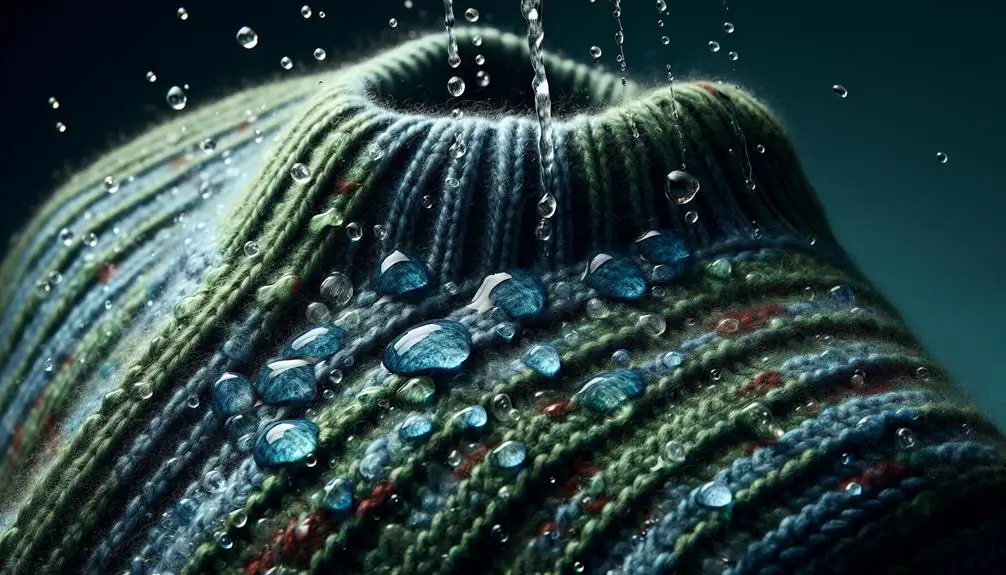Yes, wool is waterproof. Thanks to lanolin, a natural oil in wool, it repels water by forming a protective barrier. Lanolin helps wool stay dry even in damp conditions. It's pretty cool how wool can keep away water up to a third of its weight. And even if it gets wet, it still feels dry. Wool is my go-to for staying dry outdoors. So, if you want to learn more about why wool is such a reliable choice for water resistance, keep on exploring.
Table of Contents
Key Takeaways
- Lanolin in wool fibers enhances water resistance.
- Wool repels up to a third of its weight in water.
- Wool remains dry even when saturated.
- Synthetic materials may lose effectiveness over time.
- Wool is ideal for outdoor activities due to its water resistance.
Lanolin's Role in Wool's Water Resistance
Lanolin, a natural oil present in wool, actively enhances the fabric's ability to repel water by creating a protective barrier. This lanolin is like a built-in waterproofing system for wool fibers, helping them resist water penetration. The more lanolin in the wool, the better its water resistance, thanks to this natural waterproofing agent.
It's pretty cool how lanolin works its magic, making wool fibers push away water, keeping the fabric dry. Plus, lanolin doesn't just shield against moisture; it also helps maintain wool's insulating properties by preserving its structure. If your wool starts losing its water-repelling powers, don't worry! You can restore it by adding more lanolin.
This process can amp up your wool's ability to fend off moisture, making it more resistant to wet conditions. So, next time you're out in the rain and your wool coat stays dry, you can thank lanolin for keeping you cozy and snug!
Comparing Wool to Synthetic Waterproof Materials
When comparing wool to synthetic waterproof materials, wool's natural water-repellent properties outshine synthetic alternatives in outdoor activities. Wool fabrics are inherently water-resistant, capable of repelling moisture and keeping you dry in damp conditions. Unlike synthetic materials that may struggle to maintain dryness when wet, wool can repel up to a third of its weight in water, showcasing its superior water resistance. Even when thoroughly saturated, wool remains dry to the touch, making it a reliable choice for all-weather performance.
In contrast, synthetic materials like DWR-treated fabrics may offer water resistance initially, but they can lose their effectiveness over time or with repeated washings. Wool's ability to repel water sets it apart from these alternatives, making it a durable and dependable choice for outdoor activities. Whether you're hiking, camping, or simply braving the elements, wool's natural water-repellent properties guarantee that you stay comfortable and dry throughout your adventures.
Enhancing Wools Water-Repellent Properties
To enhance wool's water-repellent properties, incorporating specialized treatments like Nikwax can be highly effective. Wool naturally contains lanolin, which helps repel water. However, over time, this natural water resistance can diminish. By adding lanolin back into the wool or using treatments like Nikwax, you can restore and even improve its water repellency.
It's important to note that while treatments can enhance water resistance, they may affect the wool's natural ability to repel water. Nikwax, specifically designed for waterproofing outdoor gear, offers a reliable solution for enhancing wool's water-repellent properties without compromising its quality.
Whether you're looking to revitalize an old wool coat or boost the water resistance of your favorite wool sweater, incorporating treatments like Nikwax can help you enjoy the benefits of wool in various weather conditions.
Wools Performance in Light Rain and Snow
Enhancing wool's water-repellent properties allows it to perform effectively in light rain and snow, showcasing its practicality in damp weather conditions. Wool's natural structure and lanolin content work together to resist moisture, making it a reliable choice in light rain.
When faced with a drizzle or light snowfall, wool can shed the water droplets, keeping you dry and comfortable. The lanolin found in wool plays an essential role in repelling water, enhancing its ability to protect against light rain and snow.
This moisture resistance is one of the reasons why wool is favored for outdoor activities in varying weather conditions. Its capacity to repel light rain and snow demonstrates its effectiveness in keeping you warm and dry when the weather turns damp.
Choosing wool for light rain protection guarantees that you stay cozy and protected, allowing you to enjoy the outdoors without feeling soggy and uncomfortable.
Waterproofing Wool: Methods and Effectiveness
Waterproofing wool can be achieved by enhancing its natural water-repellent properties through methods like adding lanolin back to the fabric. Wool fibres contain natural oils like lanolin, which effectively repel water. By replenishing these oils, we can boost wool's water repellency. However, it's crucial to note that waterproofing wool may potentially compromise its inherent water-repelling abilities.
To maintain the natural water resistance of wool while enhancing it, products like Nikwax offer effective solutions designed specifically for waterproofing wool garments. These products help restore the natural oils, like lanolin, in wool, improving its water repellency without impacting its breathability.
For those looking to waterproof wool base layers or outerwear, incorporating lanolin or using products like Nikwax can significantly enhance the fabric's ability to repel water and protect against moisture. So, whether you're out exploring in light rain or heavy snow, waterproofing wool can be a crucial way to keep dry and comfortable.
Frequently Asked Questions
Can You Wear Wool in Rain?
Yes, I can wear wool in the rain. While wool can absorb water, it's fine for light rain due to its water-holding ability. For heavy rain, additional waterproofing might be needed. Understanding my wool coat's waterproofing is key.
Is Wool Resistant to the Water?
Wool naturally repels water due to its structure and lanolin. It can repel moisture up to a third of its weight. Wool's napping process helps conduct water away. Its epicuticle layer and lanolin enhance water resistance, making it great for damp conditions.
Does Wool Soak up Water?
Yep, wool soaks up water, absorbing around 30% of its weight. It's absorbent but not fully waterproof. Great for light rain but not heavy downpours. Remember, wool's water-holding ability guides choosing outerwear wisely in wet weather.
How Do You Waterproof Wool Fabric?
To waterproof wool fabric, I recommend using Nikwax products designed for this purpose. Be cautious as waterproofing may affect wool's natural water-repelling properties. Adding lanolin back to wool can also enhance its water repellency effectively.
- Engineering Fabrics for Peak Performance - July 18, 2024
- The Science Behind Breathable Fabrics - July 18, 2024
- Understanding the Strength and Durability of Fabrics - July 18, 2024







